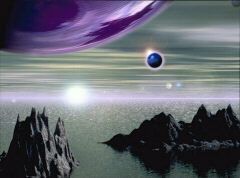|
|
|
 |
Galaxies and Nebulae: Nebulae |
 Home  Stars  Planets  Satellites  Galaxies and Nebulae 
|
A planetary nebula forms when a star can no longer support itself by fusion reactions in its center. The gravity from the material in the outer part of the star takes its inevitable toll on the structure of the star, and forces the inner parts to condense and heat up. The high temperature central regions drive the outer half of the star away in a brisk stellar wind, lasting a few thousand years. When the process is complete, the remaining core remnant is uncovered and heats the now distant gases and causes them to glow.
|